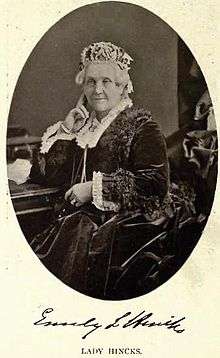Francis Hincks
| Sir Francis Hincks KCMG CB PC | |
|---|---|
 The Hon. Francis Hincks | |
| Co-Premier of Canada East | |
|
In office 1851–1854 | |
| Preceded by | Robert Baldwin |
| Succeeded by | Sir Allan Napier MacNab |
| Personal details | |
| Born |
December 14, 1807 Cork, Ireland |
| Died |
August 18, 1885 (aged 77) Montreal, Quebec, Canada |
| Nationality | Canadian |
| Political party | Reformer |
| Profession | businessman |
| Religion | Presbyterian |
The Rt. Hon. Sir Francis Hincks, KCMG CB PC (December 14, 1807 – August 18, 1885) was a Canadian politician and British Governor of Barbados from 1856 to 1862.
Born at Cork in Ireland, he was a son of the Rev. Thomas Dix Hincks and a younger brother of the noted scholars Edward Hincks and William Hincks. He was educated at Trinity College, Dublin. He entered into business in Belfast which brought him to the West Indies and from there in 1832 he came to York (Toronto), setting up an import business. He rented property from William Warren Baldwin and his son, Robert Baldwin, becoming friends with the family. He accepted a job as manager for the Farmer's Bank but became manager of the newly formed Bank of the People after the management of the Farmers' Bank became dominated by Tories. When even moderate reformers were being persecuted following the Upper Canada Rebellion of 1837, Hincks considered moving to the United States. However, the appointment of Lord Durham in 1838 provided new hope and he chose to continue in Upper Canada. That year, he established The Examiner[1] in Toronto, with the aim of promoting responsible government; this newspaper merged with The Globe, the predecessor of the Globe and Mail, in 1855.
Hincks was elected to the 1st Parliament of United Canada in 1841, representing Oxford County. In 1842, He was appointed inspector general of public accounts. In 1844, he became editor of a new newspaper in Montreal, the Pilot, which supported Reformers in both Canada East and Canada West. Because he sought subscriptions for his paper in Canada West, he came into conflict with George Brown, editor of the Globe. In 1848, he sold the paper and accepted the post of inspector general. He was Premier of the Province of Canada from 1851 to 1854. Hincks' vision of a railroad linking British North America led to the establishment of the Grand Trunk Railway in 1852 and he helped negotiate the Reciprocity Treaty of 1854 with the United States. A scandal developed in 1854 as a result of profits made by Hincks and Mayor John George Bowes of Toronto from the sale of railway stock and the government fell as a result; when this matter was reviewed in the next parliament, no basis was found for allegations of corruption against Hincks.
In 1856, he accepted an appointment as governor of Barbados and the Windward Islands, and, in 1861, became governor of British Guiana. He was knighted in 1869. On his return to Canada, he was Minister of Finance from 1869 until 1874. In 1878, he represented the federal government on the Ontario-Manitoba boundary commission.
He was also an editor of the Toronto Express newspaper. He died in Montreal of smallpox in 1885.
Family

The Hon. Sir Francis Hincks, C.B., K.C.M.G. married June 14, 1875 as his second wife Emily Louisa, daughter of Lieut.-Col. Philip Delatre, late 1st Ceylon Regiment, and his wife, Amey Scolding. Her first husband was the Hon. Robert Baldwin Sullivan, a member of the Judicial Bench, by whom she had four sons and five daughters. Judge Sullivan died April 14, 1853. Lady Hincks died in Montreal, May 14, 1880, aged 69. Sir Francis Hincks died in Montreal, August 18, 1885.[2]
Legacy
Hincks Township in Quebec was named in his honour (but was officially renamed in 1975 to Lac-Sainte-Marie).[3]
Hincks Street, Bridgetown, Barbados: In February 1861 H.R.H. Prince Alfred, the Duke of Edinburgh visited Barbados. In a bout of excess jubilation towards the visit, authorities promptly renamed several streets in and around the capital city of Bridgetown. Among the changes, one of the city's oldest streets, Madeira Street was renamed to Hincks Street after Sir Francis, the then Governor of Barbados. [4]
Notes
- ↑ Hopkins, J. Castell (1898). An historical sketch of Canadian literature and journalism. Toronto: Lincott. p. 227. ISBN 0665080484.
- ↑ Morgan, Henry James Types of Canadian women and of women who are or have been connected with Canada : (Toronto, 1903)
- ↑ "Lac-Sainte-Marie (Municipalité)" (in French). Commission de toponymie du Québec. Retrieved 2008-09-04.
- ↑ Alleyne, Warren (1978). Historic Bridgetown. Barbados: The Barbados National Trust.
References
- "Francis Hincks". Dictionary of Canadian Biography (online ed.). University of Toronto Press. 1979–2016.
- Francis Hincks – Parliament of Canada biography
- Hincks, Francis (1884). Reminiscences of his public life. Montreal: William Drysdale & Co.
| Political offices | ||
|---|---|---|
| Preceded by Robert Baldwin |
Joint Premiers of the Province of Canada - Canada West 1851–1854 |
Succeeded by Sir Allan Napier MacNab |
| Preceded by Sir John Rose |
Minister of Finance 22 February 1873–5 November 1873 |
Succeeded by Samuel Tilley |
| Government offices | ||
| Preceded by William MacBean George Colebrooke |
Governor of Barbados and the Windward Islands 1856–1862 |
Succeeded by James Walker |
| Preceded by Philip Edmond Wodehouse |
Governor of British Guiana 1862–1869 |
Succeeded by Sir John Scott |
| Parliament of Canada | ||
| Preceded by John Rankin, Cons. |
Member of Parliament from Renfrew North 1869–1872 |
Succeeded by James Findlay, Liberal |
| Preceded by Riding created in 1872 |
Member of Parliament from Vancouver 1872–1874 |
Succeeded by Arthur Bunster, Liberal |